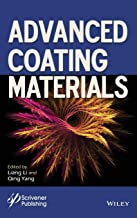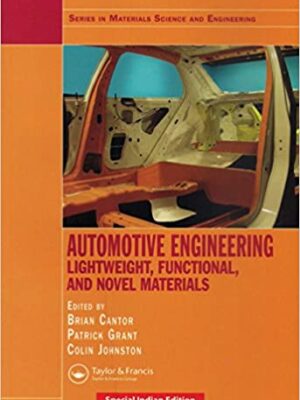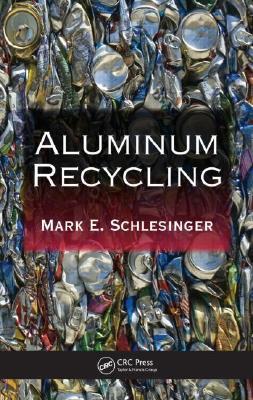Advanced Coating Materials
Original price was: ₹17,366.14.₹13,892.91Current price is: ₹13,892.91.
ISBN: 9781119407560
Author/Editor: Liang Li
Publisher: John Wiley
Year: 2018
1 in stock (can be backordered)
Description
This book covers the recent advances in coating materials and their novel applications at the cross-section of advanced materials both current and next-generation. Advanced Coatings Materials contains chapters covering the latest research on polymers, carbon resins, and high-temperature materials used for coatings, adhesives, and varnishes today. Concise chapters describe the development, chemical and physical properties, synthesis and polymerization, commercial uses, and other characteristics for each raw material and coating detailed. A comprehensive, yet practical source of reference, this book provides an excellent foundation for comparing the properties and performance of coatings and selecting the most suitable materials based on specific service needs and environmental factors.
Additional information
| Weight | 1.024 kg |
|---|
Product Properties
| Year of Publication | 2018 |
|---|---|
| Table of Contents | Preface xvii Part I: Materials and Methods: Design and Fabrication 1 1 The Science of Molecular Precursor Method 3 Hiroki Nagai and Mitsunobu Sato 1.1 Metal Complex 4 1.2 Molecular Precursor Method 6 1.3 Counter Ion (Stability) 6 1.4 Conversion Process from Precursor Film to Oxide Thin Film 8 1.5 Anatase-Rutile Transformation Controlled by Ligand 8 1.6 Homogeneity 11 1.7 Miscibility 13 1.8 Coatability (Thin Hydroxyapatite Coating of Ti Fiber Web Scaffolds) 13 1.9 Oxygen-Deficient Rutile Thin Films 15 1.10 Cu Thin Film 16 1.11 Applications Using the Molecular Precursor Method 20 1.12 Conclusion 22 References 23 2 Cold Spray-Advanced Coating Process and 3D Modeling 29 Muhammad Faizan-Ur-Rab, Saden H. Zahiri and Syed H. Masood 2.1 Introduction 30 2.1.1 Cold Spray Equipment 31 2.1.1.1 CGT KINETIKS 3000 CS System 31 2.1.1.2 Plasma Giken PCS 1000 System 32 2.1.1.3 Impact Innovations ISS 5/8 and 5/11 CS Systems 33 2.1.2 Applications of Cold Spray Coatings 35 2.2 3D Numerical Modeling of Cold Spray Coating 36 2.2.1 Computational Domain and Boundary Conditions in Numerical Model 37 2.2.2 Three-Dimensional Grid 40 2.2.3 Particle-Fluid Interaction 41 2.3 Experimental Methods of Cold Spray Coatings for Validation of 3D Model 44 2.3.1 Measurement of Substrate's Temperature 44 2.3.2 Particle Image Velocimetry (PIV) 45 2.4 Results and Discussions 48 2.4.1 3D Model Calibration 48 2.4.2 Effect of Propellant Gas 51 2.4.3 Effect of Nozzle Length 53 2.4.4 Particle's Temperature 56 2.5 Conclusion 59 References 60 3 Effects of Laser Process Parameters on Overlapped Multipass/Multitrack Hardened Bead Parameters of Ti-6Al-4V Titanium Alloy Using Continuous-Wave Rectangular Beam 65 D.S. Badkar 3.1 Introduction 66 3.2 Experimental Methodology 70 3.2.1 Principle of Rectangular Beam 70 3.2.2 Materials Used and Experimental Set-Up 70 3.2.3 Fixture Fabrication 73 3.2.3.1 Bottom Plate 74 3.2.3.2 The Top Plate 75 3.2.4 Specimen Preparation 76 3.2.5 Phase Transformations of Ti-6Al-4V During Laser Transformation Hardening 78 3.2.5.1 Laser Heating 78 3.2.5.2 Cooling or Self Quenching 78 3.3 Results and Discussion 78 3.3.1 Effect of Laser Process Parameters on Overlapped Multipass/Multitrack Hardened Bead Parameters 78 3.4 Conclusions 82 Acknowledgment 82 References 82 4 Dimensionally Stable Lead Dioxide Anodes Electrodeposited from Methanesulfonate Electrolytes: Physicochemical Properties and Electrocatalytic Reactivity in Oxygen Transfer Reactions 85 Olesia Shmychkova, T. Luk'yanenko and A. Velichenko 4.1 Introduction 86 4.2 Chemical Composition of Coatings 89 4.3 Electrocatalytical Properties of Materials 95 4.3.1 p-Nitroaniline Oxidation 98 4.3.2 p-Nitrophenol Oxidation 100 4.3.3 Oxidation of Salicylic Acid and its Derivatives 101 4.4 Electrode Endurance Tests 108 4.5 Conclusions 116 References 118 5 Polycrystalline Diamond Coating Protects Zr Cladding Surface Against Corrosion in Water-Cooled Nuclear Reactors: Nuclear Fuel Durability Enhancement 123 Irena Kratochvilova, Radek Skoda, Andrew Taylor, Jan Skarohlid, Petr Ashcheulov and Frantisek Fendrych 5.1 Introduction 124 5.2 Zr Alloy Surface Corrosion-General Description 128 5.3 Growth of Polycrystalline Diamond as Anticorrosion Coating on Zr Alloy Surface 131 5.4 Properties of PCD-Coated Zr Alloy Samples Processed in Autoclave 135 5.4.1 Oxidation of Autoclave-Processed PCD-Coated Zr Samples 135 5.4.2 Composition Changes of PCD-Coated Zr Alloy Compared to Autoclaved Zr Alloy and PCD-Coated Zr Alloy 137 5.4.2.1 Capacitance Measurements, NanoESCA, X-Ray-Photoelectron Spectroscopy, Neutron Transmission, and Mass Spectrometry 137 5.4.2.2 Raman, SEM, and SIMS Analysis of the Autoclave-Processed Samples 143 5.4.3 Mechanical and Tribological Properties of Autoclaved PCD Layer-Covered Zr Alloy 145 5.4.4 Radiation Damage Test of Autoclaved PCD-Covered Zr Alloy Sample: Ion Beam Irradiation 147 5.5 PCD Coating Increases Operation Safety and Prolongs the Zr Nuclear Fuel Cladding Lifetime-Overall Summaries 148 5.6 Conclusion 153 Acknowledgments 154 References 154 6 High-Performance WC-Based Coatings for Narrow and Complex Geometries 157 Satish Tailor, Ankur Modi and S. C.Modi 6.1 Introduction 157 6.2 Experimental 159 6.2.1 Feedstock Powder 159 6.2.2 Substrate Preparation and Coating Deposition 159 6.2.3 Why Choosing 45 Degrees and 70 Degrees Angles to Design the Connectors 163 6.2.4 Characterizations 163 6.3 Results and Discussion 164 6.3.1 Coating Mechanism Behind the Uniform Coating Properties at Both Spray Angles 45 Degrees and 70 Degrees 164 6.3.2 Coating Microstructures 164 6.3.3 Microhardness of the "As-Sprayed" Coatings 166 6.3.4 X-Ray Diffraction 167 6.3.5 Residual Stress Analysis 169 6.3.6 Adhesion Strength of the Coatings 171 6.4 Conclusions 172 References 172 Part II: Coating Materials Nanotechnology 175 7 Nanotechnology in Paints and Coatings 177 Emmanuel Rotimi Sadiku, Oluranti Agboola, Ibrahim David Ibrahim, Peter Apata Olubambi, BabulReddy Avabaram, Manjula Bandla, Williams Kehinde Kupolati, Jayaramudu Tippabattini, Kokkarachedu Varaprasad, Stephen Chinenyeze Agwuncha, Jonas Mochane, Oluyemi Ojo Daramola, Bilainu Oboirien, Taoreed Adesola Adegbola, Clara Nkuna, Sheshan John Owonubi, Victoria Oluwaseun Fasiku, Blessing Aderibigbe, Vincent Ojijo, Regan Dunne, Koena Selatile, Gertude Makgatho, Caroline Khoathane, Wshington Mhike, Olusesan Frank Biotidara, Mbuso Kingdom Dludlu, AO Adeboje, Oladimeji Adetona Adeyeye, Abongile Ndamase, Samuel Sanni, Gomotsegang Fred Molelekwa, Periyar Selvam, Reshma Nambiar, Anand Babu Perumal, Jarugula Jayaramudu, Nnamdi Iheaturu, Ihuoma Diwe and Betty Chima 7.1 Introduction 178 7.1.1 Paint and Coating 178 7.1.2 Nanopaints and Nanocoatings 180 7.1.2.1 Some Uses of Nanopaints in Different Materials 181 7.1.2.2 Nanomaterials in Paints 183 7.1.3 Types of Nanocoating 189 7.1.3.1 Superhydrophobic Coating 190 7.1.3.2 Oleophobic/Hydrophobic Coating 191 7.1.3.3 Hydrophilic Coatings 191 7.1.3.4 Ceramic, Metal and Glass Coatings 192 7.2 Application of Nanopaints and Nanocoating in the Automotive Industry 195 7.3 Application of Nanopaints and Nanocoating in the Energy Sector 196 7.4 Application of Nanocoating in Catalysis 198 7.5 Application of Nanopaints and Nanocoating in the Marine Industry 200 7.6 Applications of Nanopaints and Nanocoating in the Aerospace Industry 200 7.7 Domestic and Civil Engineering Applications of Nanopaints and Coating 202 7.8 Medical and Biomedical Applications of Nanocoating 205 7.8.1 Antibacterial Applications of Nanocoating 205 7.9 Defense and Military Applications of Nanopaints and Coatings 227 7.10 Conclusion 228 7.11 Future Trend 228 References 229 8 Anodic Oxide Nanostructures: Theories of Anodic Nanostructure Self-Organization 235 Naveen Verma, Jitender Jindal, Krishan Chander Singh and Anuj Mittal 8.1 Introduction 235 8.2 Anodization 237 8.3 Barrier-Type Anodic Metal Oxide Films 237 8.4 Porous-Type Anodic Metal Oxide Films 238 8.5 Theories or Models of Growth Kinetics of Anodic Oxide Films and Fundamental Equations for High-Field Ionic Conductivity 239 8.5.1 Guntherschulze and Betz Model 239 8.5.2 Cabrera and Mott Model 240 8.5.3 Verwey's High Field Model 242 8.5.4 Young Model 243 8.5.5 Dignam Model 244 8.5.6 Dewald Model: (Dual Barrier Control with Space Charge) 244 8.6 Corrosion Characteristics and Related Phenomenon 246 8.7 Electrochemical Impedance Spectroscopy 249 8.8 Characterization Techniques 250 References 251 9 Nanodiamond Reinforced Epoxy Composite: Prospective Material for Coatings 255 Ayesha Kausar 9.1 Introduction 256 9.2 Nanodiamond: A Leading Carbon Nanomaterial 256 9.3 Epoxy: A Multipurpose Thermoset Polymer 258 9.4 Nanodiamond Dispersion in Epoxy: Impediments and Challenges 259 9.5 Epoxy/Nanodiamond Coatings 261 9.6 Coating Formulation 262 9.7 Industrial Relevance of Epoxy/ND Coatings 264 9.7.1 Strength and High Temperature Demanding Engineering Application 264 9.7.2 Thermal Conductivity Relevance 266 9.7.3 Microwave Absorbers 268 9.7.4 In Biomedical 268 9.8 Summary, Challenges, and Outlook 269 References 270 10 Nanostructured Metal-Metal Oxides and Their Electrocatalytic Applications 275 Kemal Volkan OEzdokur, Suleyman Kocak and Fatma Nil Erta? 10.1 Brief History of Electrocatalysis 276 10.2 Electrocatalytic Activity 278 10.3 Oxygen Reduction Reaction 280 10.4 Transition Metal Chalcogenides and Their Catalytic Applications 281 10.5 Preparation of Nanostructured Transition Metal Oxide Surfaces 296 10.6 Polyoxometallates (POM) 303 10.7 Future Trends in Electrocatalysis Applications of Metal/metal oxides 305 References 305 Part III: Advanced Coating Technology and Applications 315 11 Solid-Phase Microextraction Coatings Based on Tailored Materials: Metal-Organic Frameworks and Molecularly Imprinted Polymers 317 Priscilla Rocio-Bautista, Adrian Gutierrez-Serpa and Veronica Pino 11.1 Solid-Phase Microextraction 317 11.2 HS-SPME-GC Applications Using MOF-Based Coatings 320 11.2.1 Metal-Organic Frameworks (MOFs) 320 11.2.2 SPME Coating Fibers Based on MOFs 322 11.3 DI-SPME-LC Applications Using MIP-Based Coatings 331 11.3.1 Molecularly Imprinted Polymers (MIPs) 332 11.3.2 SPME Coating Fibers Based on MIPs 333 11.3.3 MIPs and MOFs Features as SPME Coatings 340 11.4 Conclusions and Trends 341 Acknowledgements 341 References 342 12 Investigations on Laser Surface Modification of Commercially Pure Titanium Using Continuous-Wave Nd:YAG Laser 349 Duradundi Sawant Badkar 12.1 Introduction 350 12.2 Experimental Design 354 12.3 Experimental Methodology 355 12.4 Results and Discussions 358 12.4.1 Analysis of Variance (ANOVA) for Response Surface Full Model 358 12.4.2 Validation of the Models 366 12.4.3 Effect of Process Factors on Hardened Bead Profile Parameters 370 12.4.3.1 Heat Input (HI) 370 12.4.3.2 Hardened Bead Width (HBW) 370 12.4.3.3 Hardened Depth (HD) 374 12.4.3.4 Angle of Entry of Hardened Bead Profile (AEHB) 377 12.4.3.5 Power Density (PD) 381 12.4.4 Microstructural Analysis 384 12.5 Conclusions 387 Acknowledgements 390 References 390 13 Multiscale Engineering and Scalable Fabrication of Super(de)wetting Coatings 393 William S. Y. Wong and Antonio Tricoli 13.1 Introduction 394 13.2 Fundamentals of Wettability and Superwettability 395 13.2.1 Defining Hydrophilicity and Hydrophobicity 397 13.2.2 Defining Superhydrophilicity and Superhydrophobicity 398 13.2.2.1 Wenzel's Model 398 13.2.2.2 Cassie-Baxter's Model 399 13.2.2.3 Contact Angle Hysteresis 400 13.2.2.4 Variants of Superhydrophilicity 402 13.2.2.5 Ideal Superhydrophilicity 402 13.2.2.6 Hemiwicking Superhydrophilicity 402 13.2.2.7 Variants of Superhydrophobicity 403 13.2.2.8 Ideal Lotus Superhydrophobicity 403 13.2.2.9 Petal-Like Adhesive Superhydrophobicity 404 13.2.3 Defining Superoleophobicity, Superamphiphobicity and Superomniphobicity 405 13.2.3.1 Superoleophobicity and Superamphiphobicity 405 13.2.3.2 Superomniphobicity 407 13.2.3.3 Re-Entrant Profiles 407 13.2.3.4 Shades of Grey: Superoleo(amphi) phobicity to Superomniphobicity 408 13.2.4 Characterization Techniques 409 13.2.4.1 Static Contact Angle Analysis 409 13.2.4.2 Dynamic Contact Angle Analysis-Contact Angle Hysteresis 411 13.2.4.3 Dynamic Contact Angle Analysis-Sliding Angle 412 13.2.4.4 Other Modes of Dynamic Analysis-Droplet Bouncing and Fluid Immersion 412 13.3 Nature to Artificial: Bioinspired Engineering 413 13.3.1 Superhydrophilicity 414 13.3.2 "Lotus-Like" Low-Adhesion Superhydrophobicity 416 13.3.3 "Rose Petal-Like" High-Adhesion Superhydrophobicity 416 13.3.4 Anisotropic Low-Adhesion/High-Adhesion Superhydrophobicity 417 13.3.5 Superhydrophobic-Hydrophilic Patterning 418 13.3.6 Superoleo(amphi)phobicity 418 13.4 Top-Down and Bottom-Up Nanotexturing Approaches 419 13.4.1 Templating 419 13.4.2 (Photo)-Lithography 420 13.4.3 Scalable Bottom-Up Texturing Approaches 421 13.5 Superhydrophilicity 421 13.5.1 The State of Superhydrophilicity 421 13.5.1.1 Plasma and Ozone Surface Hydroxylation 421 13.5.1.2 Aerosol Deposition 422 13.5.1.3 Electrospinning 423 13.5.1.4 Chemical Etching Hydroxylation 424 13.5.1.5 Wet-Deposition 424 13.5.1.6 Sol-Gel and Photoactivation 424 13.5.1.7 Thiol-Functionalization 425 13.6 Superhydrophobicity 426 13.6.1 Ideal Lotus Slippery Superhydrophobicity 426 13.6.1.1 Plasma 426 13.6.1.2 Chemical Vapor Deposition 427 13.6.1.3 Spraying (Wet-Spray, Liquid-Fed Flame Spray, Sputtering) 428 13.6.1.4 Wet-Deposition 433 13.6.1.5 Sol-Gel 434 13.6.1.6 Electrodeposition 435 13.6.1.7 Chemical Etching 436 13.6.2 Petal-Like Adhesive Superhydrophobicity 437 13.6.2.1 Templating 437 13.6.2.2 Liquid-Fed Flame Spray Pyrolysis 438 13.6.2.3 Sol-Gel and Hydrothermal Synthesis 438 13.6.2.4 Electrospinning 440 13.6.2.5 Electrodeposition 441 13.6.2.6 Micro- and Nanostructural Self-Assembly 441 13.6.2.7 Mechanical Methods 442 13.7 Superoleophobicity and Superamphiphobicity 443 13.7.1 Nanofilaments, Fabric Fibers, Meshes, and Tubes 443 13.7.2 Aerosol-Coating (Wet-Spray, Candle Soot / Liquid-Fed Flame Spray) 445 13.7.2.1 Wet-Spray Deposition 445 13.7.2.2 Flame Soot Deposition 445 13.7.2.3 Flame Spray Pyrolysis 447 13.7.3 Sol-Gel 448 13.7.4 Wet-Coating (Dip- and Spin-Coating) 448 13.7.4.1 Dip-Coating 448 13.7.4.2 Spin-Coating 449 13.7.5 Micro- and Nanostructural Self-Assembly 449 13.7.6 Electrospinning 450 13.7.7 Electrodeposition and Electrochemical Etching 450 13.7.7.1 Electrochemical Etching 450 13.7.7.2 Electrodeposition 451 13.7.8 Perfluoro-Acid Etching 452 13.7.9 Physical Etching 452 13.8 Superomniphobicity 452 13.8.1 Electrospun Beads on Mesh-Like Profiles 453 13.8.2 Controlled Sol-Gel Growth 455 13.8.3 Etched Aluminum Meshes 455 13.8.4 Hybridized Lithography 455 13.9 Conclusions 456 References 457 14 Polymeric Materials in Coatings for Biomedical Applications 481 Victoria Oluwaseun Fasiku, Shesan John Owonubi, Emmanuel Mukwevho, Blessing Aderibigbe, Emmanuel Rotimi Sadiku, Yolandy Lemmer, Idowu David Ibrahim, Jonas Mochane, Oluyemi Ojo Daramola, Koena Selatile, Abongile Ndamase and Oluranti Agboola 14.1 Introduction 482 14.1.1 Coating Materials 483 14.2 Polymeric Coating Materials 484 14.2.1 Structure, Synthesis, and Properties 485 14.2.1.1 Polyvinyl Alcohol (PVA) 485 14.2.1.2 Parylene 486 14.2.1.3 Polyurethane (PU) 487 14.2.2 Coating Methods 489 14.2.3 Biomedical Coating Applications 492 14.2.3.1 Antifouling Coating 492 14.2.3.2 Nanoparticle Coating for Drug Delivery 493 14.2.3.3 Implants Coating 495 14.2.3.4 Cardiovascular Stents 497 14.2.3.5 Antimicrobial Surface Coating 498 14.2.3.6 Drug Delivery Coating 499 14.2.3.7 Tissue Engineering Coating 500 14.2.3.8 Sensor Coating 501 14.3 Conclusion 502 References 503 |
| Author | Liang Li |
| ISBN/ISSN | 9781119407560 |
| Binding | Hardback |
| Edition | 1 |
| Publisher | John Wiley |
You must be logged in to post a review.






Reviews
There are no reviews yet.